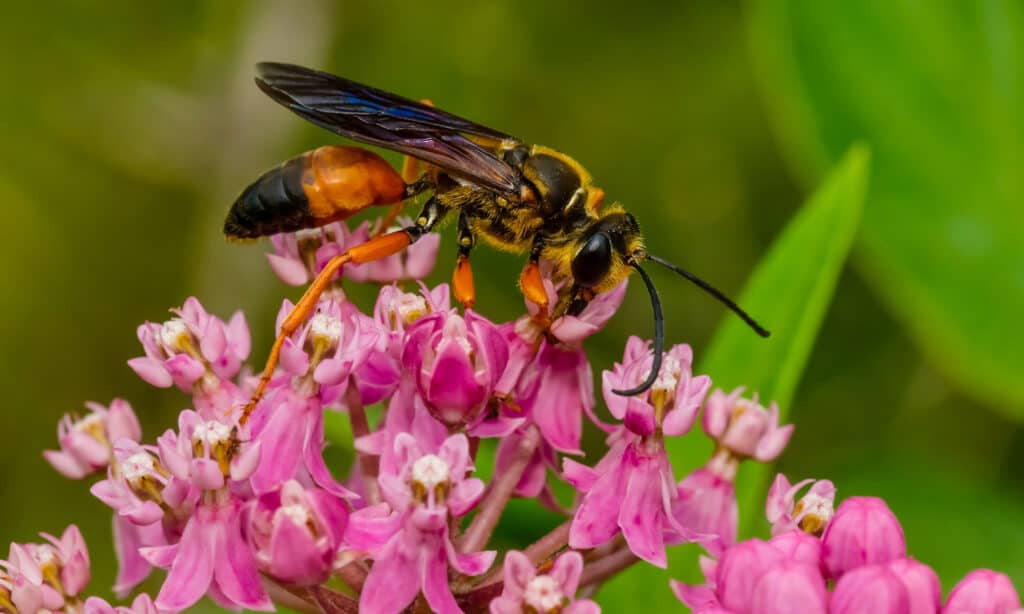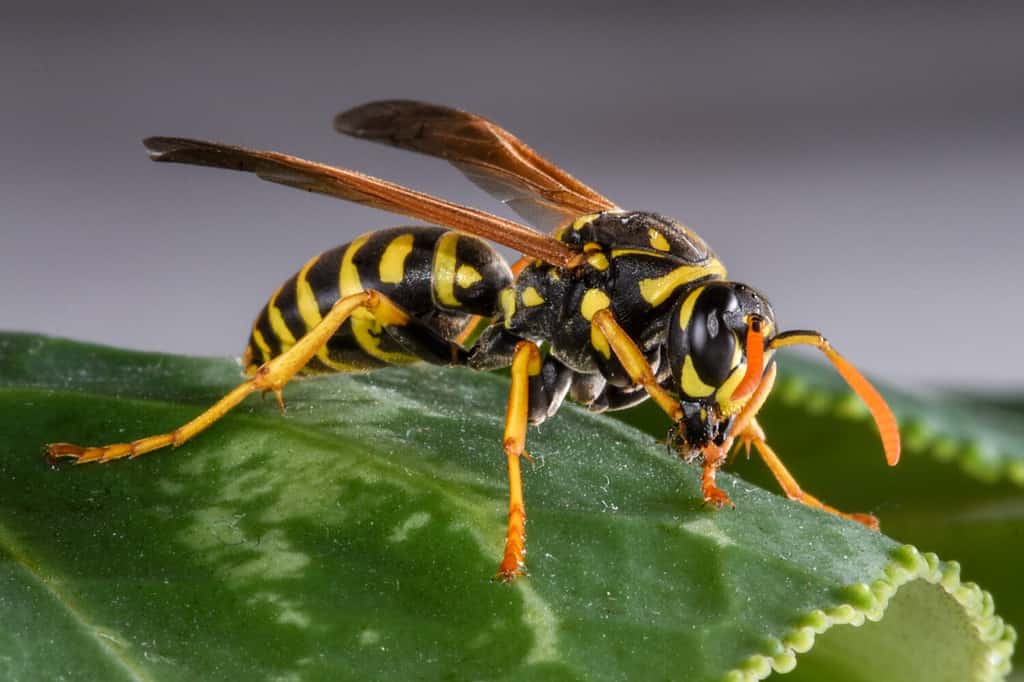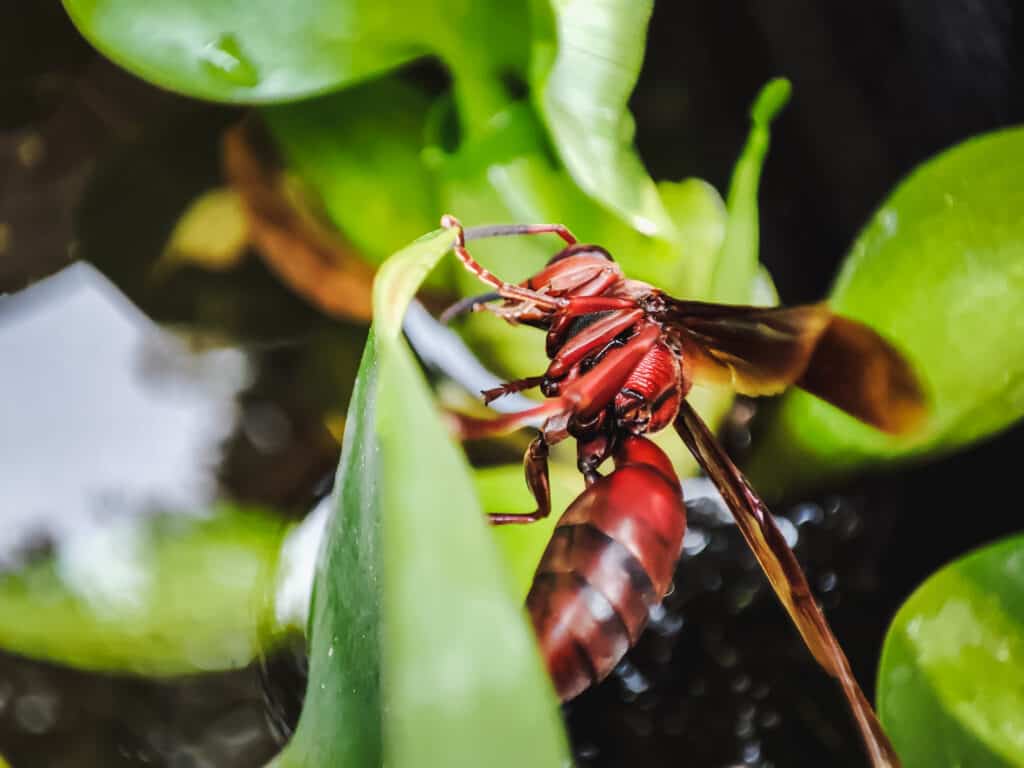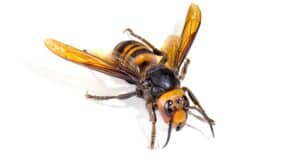Welcome to the buzzing world of wasps in Georgia, where we’ll unveil an intriguing ranking based on the pain they can inflict with their stingers. Prepare to be amazed as we explore the diverse array of these winged creatures that call the Peach State home.
From the small yet potent zingers to the formidable furies that can make you yelp in pain, we’ll take you on a thrilling journey through the various types of wasps found in Georgia. Brace yourself for some surprising discoveries about these tiny but mighty insects. Let the sting game begin!
5: Cicada Killer Wasp (Sphecius speciosus)

Cicada killer larvae sustain themselves by feeding on cicadas and other insects.
©samray/Shutterstock.com
Cicada killers emerge during the summer months in Georgia, typically in late June or July. These impressive wasps are commonly spotted either visiting flowers or constructing burrows in sandy or light soil.
With a substantial size of around 2 inches, they showcase a black or dark brown body adorned with vibrant yellow markings on various segments of their abdomen. Their wings have a lovely amber hue.
Habitat
These solitary wasps have a particular preference for habitats that possess specific characteristics. They seek out well-drained, light-textured soils that bask in full sunlight, particularly those near trees that serve as homes for cicadas.
Whether it’s along the edges of sidewalks or patios, in flower beds, gardens, or even lawns, cicada killers are known to dig extensive tunnels for raising their young. The excavation process can displace several pounds of soil, occasionally leading to minor damage, such as destabilizing a brick patio resting on sandy ground.
Diet
Cicada killer larvae sustain themselves by feeding on cicadas and other insects, while the adults nourish themselves with flower nectar, fermented sap from trees, and other sizeable plant sources within their habitat. True to their name, these wasps excel at preying upon cicadas. Cicada killers are adept hunters. The female wasps locate cicadas by their sound and capture them in flight. They use their powerful mandibles to paralyze the cicadas, then carry them to their burrows as provisions for their offspring.
Aggression
Male cicada killers are often seen engaging in territorial battles. They fiercely defend specific areas and engage in aerial combat with other males to secure mating opportunities with females.
Despite their intimidating appearance, measuring a hefty 2 inches in length, cicada killers generally pose a relatively mild threat to humans in terms of their sting. They are generally non-aggressive towards humans and other animals unless directly threatened or handled. They are primarily focused on hunting and nesting activities. Most individuals who have experienced a sting from these wasps tend to rate the pain as considerably lower than that inflicted by a honeybee.
Although not specifically mentioned on the Schmidt Sting Pain Index, it is plausible to assign these wasps the lowest rating of 1 based on available information.
4: Golden Digger Wasp (Sphex ichneumoneus)

While they enjoy flower nectar as nourishment, their resourcefulness extends to capturing and paralyzing katydids and crickets.
©Paul Reeves Photography/Shutterstock.com
In the grassy fields of Georgia, you’ll encounter the gentle nature of great golden digger wasps. These fascinating creatures do not feel the need to defend their nests or show aggression towards humans. On the contrary, they contribute more benefits than harm to their surroundings.
With an attractive appearance, their abdomen exhibits a delightful combination of orange or rusty-red at the front and a contrasting black hue at the end. The head and thorax are adorned with stunning golden hairs. These impressive wasps can grow up to 1½ inches in length, with females being larger than males.
Habitat
A common sight in open areas, especially fields, great golden digger wasps frequently visit flowers to indulge in the sweet nectar they provide. You’ll often spot them in search of food. These industrious insects prefer sandy soils when it comes to digging their nests.
Golden digger wasps are solitary insects that construct individual burrows for nesting. The female wasps excavate tunnels in the ground, often in sandy or loamy soil. They create chambers within the burrow where they lay eggs and provide provisions for their offspring. And like many other solitary wasps, golden digger wasps do not survive the winter. The adult wasps die off, and the next generation emerges in the following spring.
Diet
While they enjoy flower nectar as nourishment, their resourcefulness extends to capturing and paralyzing katydids and crickets. They fly or haul these immobilized prey to their burrows, carefully placing them in designated nest cells to feed their young.
As they go about their daily activities, great golden digger wasps contribute to soil aeration and help control unwanted pests in your yard.
Aggression
Females possess a limited supply of venom, which they use to paralyze small insects for their larvae’s sustenance. On the other hand, males do not possess stingers at all. While they may put on an impressive show by hovering near their nest when you approach, these wasps rarely resort to stinging.
It’s only when they feel threatened or handled that the females may use their stingers. Similar to the cicada killer wasp, the sting of a great golden digger wasp would rank lowest (Rank 1) on the Schmidt Sting Pain Index.
3: Four-Toothed Mason Wasp (Monobia quadridens)

The body of a four-toothed mason wasp is usually smooth and shiny, without any hair.
©Wilfreda Wiseman/Shutterstock.com
Four-toothed mason wasps, commonly found in Georgia, are easily identifiable due to their distinct features.
Their wings exhibit noticeable white markings near the “shoulder areas,” with a thin white band positioned just behind them. Additionally, a wide band can be observed at the front of their abdomen, in what is commonly referred to as the “waist area.” The remainder of their abdomen and body remains solid black.
The body of a four-toothed mason wasp is usually smooth and shiny, without any hair. As a result, instead of getting stuck to their bodies as it does on bees, pollen tends to collect on the legs and feet of these wasps.
Habitat
When seeking a suitable nesting location, each female four-toothed mason wasp diligently searches for preexisting burrows or tunnels. These can include abandoned passages left by beetles, carpenter bees, hollow stems, and similar spaces. Interestingly, this species is known to occasionally utilize bee hotels as well, showcasing their adaptability.
Diet
Adult four-toothed mason wasps primarily consume nectar from flowers, while their larvae sustain themselves by feeding on caterpillars. To acquire their prey, female wasps employ their elongated mandibles to capture caterpillars, subsequently paralyzing them with a venomous sting.
Aggression
Similar to other wasp species, the four-toothed wasp is equipped with a potent stinging capability. The pain inflicted by a female’s sting is akin to that caused by the ant Myrmecia nigriceps or the bald-faced hornet.
However, unlike most wasps, even the male four-toothed mason wasp possesses the ability to deliver a painful jab resembling a needle prick, although it does not inject venom. The male’s stinger-less abdomen tip serves as its tool for this temporary discomfort.
Due to the heightened intensity of their stings compared to golden digger wasps, four-toothed mason wasps rank at level 2 on the Schmidt Sting Pain Index.
While four-toothed mason wasps may deliver painful stings, they also provide benefits to ecosystems. By hunting and controlling caterpillar populations, they help regulate pest populations and contribute to the natural balance of insect populations.
2: Eastern Yellowjacket (Vespula maculifrons)

Feeding on a carnivorous diet, yellow jackets primarily prey on other insects like flies and bees.
©Randy Runtsch/Shutterstock.com
The eastern yellowjacket, a common resident of Georgia, can be quite a nuisance as it has a tendency to construct nests in residential areas.
These social wasps, resembling bees in size, have a distinctive appearance with black bodies adorned with yellow markings on the front of their heads and yellow bands encircling their abdomens. Their predominantly yellow faces and dark eyes make them easily recognizable. When at rest, the front wings of these wasps are neatly folded lengthwise, and their large antennae are quite conspicuous.
Habitat
You can find these versatile wasps in various habitats, including urban, suburban, and agricultural areas. They are particularly adaptable, making their homes underground as well as in man-made structures such as houses, garages, and other similar locations.
Diet
Feeding on a carnivorous diet, yellow jackets primarily prey on other insects like flies and bees. However, they also have a taste for picnic food, fruits, carrion, and the sweet nectar found in flowers. These resourceful insects will travel up to a mile from their nest in search of food.
Despite their prevalence, yellow jackets face numerous predators in their environment, many of which are much larger mammals. For instance, raccoons, black bears, and skunks have been identified as major predators in Georgia and Indiana. When attacking a colony, raccoons employ a strategic approach of digging to unearth the nest, distributing brood cells, and ultimately removing individual broods from their cells using their teeth.
Aggression
Yellow jackets are known for their aggressive defense of their hives against potential threats, and their stings can be quite painful. When provoked, they can exhibit aggressive behavior and sting repeatedly. It’s important to be cautious and avoid sudden movements or disturbing their nests to minimize the risk of stings.
When a yellow jacket stings, it punctures the skin with its stinger and injects a venom that induces sudden pain. Yellow jacket stings rank at number 2 on the Schmidt Sting Pain Index, highlighting their potency.
1: Red Paper Wasp (Polistes carolina)

The red paper wasp with the Latin name Polistes canadensis, perches on aquatic plants.
©iStock.com/Riki I Gunawan
Red paper wasps, found in Georgia, should be avoided due to the excruciating pain caused by their stings.
These wasps belong to the paper wasp family and are easily identifiable by their reddish-brown bodies, reaching up to an inch in size, and distinctive dark wings.
Diet
During the day, red paper wasps actively forage for food, preying on beetle larvae, flies, caterpillars, and insects that consume plant nectar.
Habitat
Their nests are constructed using a paper-like material formed by chewing plants and wood fibers mixed with saliva. The dried nests resemble an upside-down umbrella or dome featuring exposed honeycomb-like cells at the bottom. They prefer sheltered areas for nesting, such as natural spaces within vegetation or tree cavities. However, man-made structures like bridges, roofs, chimneys, and eaves also serve as common nesting sites.
Red paper wasp nests are typically home to over 800 wasps. Each colony typically consists of a queen, female workers, and males. The queen is responsible for laying eggs and initiating the colony, while the workers perform various tasks such as nest building, foraging for food, and caring for the brood. Male wasps, also known as drones, mate with new queens during the reproductive phase. Interestingly, red wasps do not reuse their nests, preferring to construct new ones each time.
Aggression
While most paper wasps are not particularly aggressive, red paper wasps have gained a reputation for being highly aggressive and delivering intensely painful stings. Unlike bees, they do not lose their stingers and can sting multiple times.
The stings of red paper wasps typically cause immediate pain, but the effects are generally temporary. However, in rare cases, individuals who are highly allergic to the wasp’s venom may experience a severe allergic reaction. Although not as aggressive as yellow jackets, red paper wasps can inflict more intense pain when they sting. For all the right reasons, they are one of the few wasps that rank at number 3 on the Schmidt Sting Pain Index.
Considering their painful stings and potentially severe allergic reactions, it is advisable to steer clear of red paper wasps in Georgia.
Summary Of The Types Of Wasps In Georgia Ranked By The Pain Of Their Sting
| Rank | Wasp | Schmidt Sting Pain Index |
|---|---|---|
| 5 | Cicada Killer Wasp | Rank 1 |
| 4 | Golden Digger Wasp | Rank 1 |
| 3 | Four-Toothed Mason Wasp | Rank 2 |
| 2 | Eastern Yellowjacket | Rank 2 |
| 1 | Red Paper Wasp | Rank 3 |
The photo featured at the top of this post is © Yuttana Joe/Shutterstock.com
Thank you for reading! Have some feedback for us? Contact the AZ Animals editorial team.






